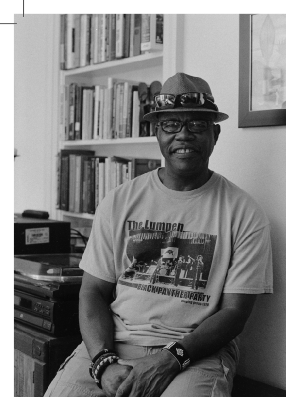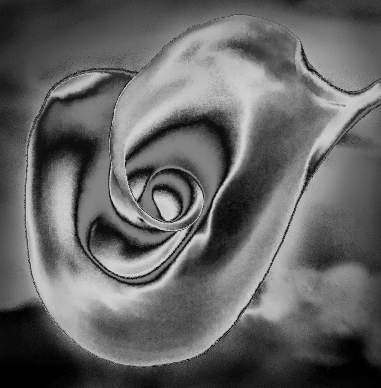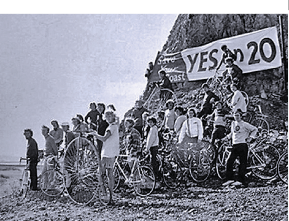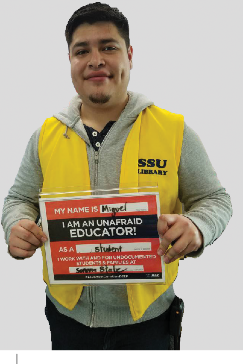Sonoma State University Library at the Jean and Charles Schulz Information Center
Table of Contents
The Sonoma State University Library fosters a transformative and welcoming environment for learning and scholarship, and empowers its community to be fluent users and creators of information across and beyond the curriculum.
Library News is published by the Sonoma State University Library.
Dean: Karen G. Schneider
Editor: Hilary Smith
Contributors: Lynn Prime, Patty Lyn Tweten
From the Dean

Dean of SSU Library
The Library’s recent events remind me why I love what I do and feel so passionately about the role of libraries in society.
We have heard Dr. Sakaki talk about her family’s incarceration during World War II and witnessed the artifacts of that shameful time in American history. Just last week former Black Panthers reminded us of the many services they provided “back in the day,” from food drives to health clinics. Last November, faculty, students, and community members gathered to discuss Between the World and Me, Ta-Nehisi Coates’ book about his experiences as an African American.
These events represent memory work, a concept developed by French historians after World War II, when people uncomfortable with the grim and sometimes shameful realities of the French Occupation began presenting what we would call today “alternative facts.” The concept of memory work is deceptively simple: as Paul Ricoeur argued in History and Truth, history cannot be constructed from memory alone. History requires archival data: documents, testimony, evidence.
The Library at Sonoma State University provides many services: study space, books, journals, instruction in research skills, and even innovation labs. We also ensure every student at Sonoma State University has access to technology. For example, since July 1, students have checked out laptops from the Library almost 6,000 times.
But the most important role of our library is in the service of memory work. We serve as sanctuaries of the truth and protectors of history. And that’s a pretty inspiring thought to wake up to every day.
Exhibits
Revolutionary Grain: Celebrating the spirit of the Black Panthers in portraits and stories
On March 27, the Library hosted an historic panel discussion with former founders and “foot soldiers” of the Black Panther Party. The event inaugurated the exhibit Revolutionary Grain: Celebrating the spirit of the Black Panthers in portraits and stories by documentary photographer, Suzun Lucia Lamaina. The exhibit is based on Lamiana’s book of the same name, published in 2016 to coordinate with the 50th Anniversary of the Black Panther party. It features portraits of Party members and testimonials reflecting upon their experiences.

by Suzun Lamaina
The Path of Social Justice
Dr. Judy K. Sakaki, President of Sonoma State, introduced the panel and guests to a crowd of over 150 students, faculty and community members. She recalled her awareness of the Black Panther Party’s social activism during her childhood in Oakland, and drew a parallel between the youth of the Party founders in the 1960s, and the current age of many Sonoma State Students. She linked the Black Panther Party’s influence to social justice programs of today, noting that “democracy is not a spectator sport.”
Moderated by SSU Pro-fessor Kim Hester-Williams, the panel included Black Panther luminaries Elbert “Big Man” Howard, Barbara Easley Cox, Billy X Jennings, Emory Douglas, and photographer Suzun Lamaina. Through the course of the evening, their stories unfolded.
Big Man described founding the Black Panthers in 1966 with Huey P. Newton and Bobby Seale. They were galvanized by three events: the murder of Malcom X, the establishment of Miranda Rights by the Supreme Court, and the Watts riots in Los Angles in 1965. Although his association with the party placed him under FBI surveillance, Billy X remains an advocate for the Party’s mission to educate and organize the black community. He described The Black Panther newspaper as the Party’s “life blood.” Emory Douglas’ iconic art and imagery — still recognized today — emerged from the newspaper’s pages.
Barbara Easley Cox followed her husband, Don Cox, a Panthers Field Marshall, in exile to Algiers. As a new mother, she found herself surrounded by the wives of the Black Panther revolutionaries. The experience informed her lifetime role as a social worker and literacy advocate.
Lamaina’s inspiration for her book was “the undying love and ‘powee of the people’ that the young men and women of the Black Panther Party had for serving [the community].” Since the 1970s, she had wanted to photograph the Black Panthers. Returning to the idea in 2010, Lamaina spent the next 5 years photographing and cataloging Black Panther Party members’ stories.
Visual Voice
The portraits are simple but compelling. Lamaina’s mission was to capture each person’s story in their own words and photograph them. Her process includes searching for visual clues within the subject and the environment to bring out the essence the individual. Nothing in the photograph is present by accident. “The relationship between all the elements in a photograph are what gives it a visual voice,” she explains. She also refers to her dark room as “a magical place where chemistry becomes alchemy.”
Lamaina ended the panel discussion by embracing Sonoma State’s Library for ex-hibiting her work. She declared, “Libraries are our futures, are our ‘now,’ and they’re FREE.”
Revolutionary Grain: Celebrating the Spirit of the Black Panthers in Portraits and Stories is sponsored by the SSU Library and made possible by the Jean and Charles Schulz Endowment.
Anatomy of an Exhibit

December 2015 — January 2016
It began with an NEH Grant
Dana Shew is an Oral Historian and Staff Archaeologist at the Anthropological Studies Center at Sonoma State. In 2015, Dana was awarded a grant to further pursue a topic that had captivated her since she wrote her Master’s thesis on it at the University of Denver: The Amache Japanese Internment Camp in Colorado. The NEH Common Heritage grant provided funds to digitize historical items Amache interment survivors and their families.
March-June, 2016
Library Contact
A portion of Dana’s grant was for public outreach, such as an exhibit of website. She approached the library facility imagining something small, but Karen Schneider, Library Dean, and Hilary Smith, Research Instruction Librarian, were very enthusiastic. Hilary says, “There are so many connected areas in that exhibit: The NEH, scholarly works, anthropology, etc. We said, ‘Let’s support this!’”
Digitization
A number of Amache internees came from west Sonoma County. Dana worked with the Japanese American Citizens League to set up a digitization day in Sebastopol, CA. Armed with flatbed scanners and a digital camera, Dana scanned over 200 items. Now that she knew she would have an exhibit space, she asked the people for their permission to borrow items. “The fact that they were there sharing in the first place — it was one more step to get permission to exhibit them. No one said ‘no’,” she recalls.
July, 2016
The Exhibit Gains Visibility
While planning the exhibit, Dana became aware that the new Sonoma State University President, Dr. Judy Sakaki, is a Japanese American who is very interested in WWII internment history. Optimistically, she clicked on the “event/speech” request link on the SSU website to invite her. To her surprise, Dr. Sakai said agreed. “The President was delighted at the opportunity to connect with local community members,” notes Hilary Smith. Dr. Sakaki was so enthused by the exhibit that she returned the next day with members of the Sonoma State Board of Trustees.
September, 2016
A Game Changer
The Amache exhibit’s opening reception was planned for September in the library. Now that Dr. Sakaki was attending and speaking at the event, the event was a good opportunity to have donors, faculty and the local community in attendance. The guest list grew, and suddenly, there was the logistical challenge of getting 200+ people, some of them elderly, access to speakers, catering and the gallery. Mark Stapp, a Development Officer with SSU, stepped in to help meet the demands of protocol and a larger event. At the reception, the gallery was full to bursting.
October-December, 2016
A Broad Reach
The reception heightened public interest in the Amache exhibit. Attendance remained strong from the opening to the actual day of deinstallation. High school groups, community groups, Sonoma State classes and members of the public attended to see artifacts such as lamp bases made out of yucca root, and printed items from Amache’s silk screen shop (which was initially built to print war posters for the navy. ) Dana reflects on the growth of her project, “It reached beyond the University community and beyond the Japanese American community — beyond what I expected.”
January, 2017
Amache Items Travel
Artifacts from the exhibit will travel to Oakland at the Asian Cultural Center in June. The digitized images will be made available to the public through the Amache Museum in Colorado, DENSHO.org, and the CSU Japanese American History Project.
Gift of Beauty Artist Aryan Chappell donates Flagship Photograph to SSU Library

image. Calla means “most beautiful” in Greek.
Library Dean Karen Schneider said she was “thrilled, humbled, and honored” on behalf of the Library when local photographer and SSU graduate Aryan Chappell informed her that he would be donating his photograph, “Calla Lily,” to the University Library. Aryan’s donation follows a well-received exhibit of his photography in the Library Gallery January through March of this year.
“I feel fortunate to have come into a peculiarly creative family.” Aryan Chappell shared this thought in a recent interview with Rfotofolio.org. His mother was a painter and designer, and his father was a photographer. Living off the grid in rural locations in California and New Mexico meant that his childhood living room often served as dark room, paint studio, and Hot Wheels test track. Chappell tried to rebel by being normal. Fortunately for us, his rebellious period did not last.
For the past 30 years, Aryan Chappell has been capturing images of his family and his surroundings in Northern California. Every 10 years, he reflects back with a retrospective show. The SSU Library was proud to recently host this decade’s offering, A Creative Stream: 30 years of photography.
Like a Gem
Chappell spoke to the Library about how he creates his art. “Some things are like a gem. The longer it sits, the better it gets.” For example, the image below, Family Circle, started as a family snapshot. “What ended up happening so exemplified the family circle notion. It was a real gift.” Calla Lily has a similar story. Aryan had attended the exhibit reception for the work of his mentor and noted local photojournalist, John LeBaron, and on the way out saw a lily. The moment he captured became the flagship image for his thirty-year retrospective.
The show’s images result from both traditional and digital photography. Although he describes his own entry into the digital world as “starting all over,” Chappell has embraced the new technology. “To attempt to make a work of art, even with digital images, you need to spend time editing. It takes work, diligence, and knowing your tools.”
Chappell is philosophical about the future of photography. “What would George Eastman think today,” he asks. “I wonder what Steve Jobs thought. I look at these waves of photography — Brownie, Kodak — and, now you can fill up this little phone with pictures.”
Long after the exhibit closes, Aryan Chappell’s work will be remembered through his generous donation.
Special Collections: C.O.A.A.S.T.

How it kept the California Coast clear
The first environmental collection to be added to SSU’s Special Collections was a series of scrapbooks donated by environmental activists Bill and Lucy Kortum in 1978. The late Bill Kortum was a founder of C.O.A.A.S.T. (Californians Organized to Acquire Access to State Tidelands), which was formed in 1968 to preserve public coastal access in California and went on to champion numerous other environmental issues in its 25-year history.
In 1968, Kortum, Ernestine Smith and Charles Rhinehart began to collect press stories, correspondence, and other items about the controversy over the development of the Sea Ranch community, which threatened to limit public access to the Sonoma County coastline. Items were added to and arranged into scrapbooks by C.O.A.A.S.T. archivist Gladys O’Connell. The volumes are organized around items related to the development of the California coastline and the legislative efforts relating to the successful passage of the Coastal Zone Conservation Act (Proposition 20) of 1972.
Other issues in the scrapbooks include the proposed nuclear reactor at Bodega Bay, dredging at the mouth of the Russian River, and the establishment of the California Coastal Commission.
To learn more about the C.O.A.A.S.T. Scrapbook Collection, visit the Online Archive of California at www.oac.cdlib.org. Some scrapbook items can be viewed online in the North Bay Digital Collection’s Environmental History Digital Collection. Appointments to view the original scrapbooks can be made by contacting the SSU Special Collections.
Special Collections
The University Library is home to a growing collection of important and unique material on the history of environmental issues and activism in the North Bay over the last 60 years. These collections will be featured in this and future issues of the Library newsletter.
In Brief
Open Access Initiative

At Sonoma State, the Library has its own Open Access strategic mission, and a new librarian to implement it. Rita Premo, the new Scholarly Communications Librarian, is here to advocate Open Access and teach faculty, staff and students to consider their options before publishing their works. Adhering to Open Access is voluntary, but Rita would like the faculty to be aware of the basic tenets and benefit of sharing their information out of the scholarly environment. She plans to offer Open Access workshops to educate faculty and staff and students. Rita explains that Open Access is an extension of the library’s purpose. “Part of the library status and mission is to make students good consumers, users and producers of information.”
Open Access is: Harvard scholar and open access advocate Peter Suber defines open access as scholarly literature “that is digital, online, free of charge, and free of most copyright and licensing restrictions.”
SSU President Investiture
The Investiture of Dr. Judy K. Sakaki, the new president of Sonoma State University, will be held on April 20, 2017. Defined as the “act of ceremony of conferring the authority and symbols of a high office,” the day-long celebration will include several events, including a reception, a concert at the Green Music Center by the group Hiroshima, and an exhibit in the University Library Gallery of Dr. Sakaki’s personal items entitled, “I am because ... Dr. Judy K. Sakaki’s Journey to the SSU Presidency.” The public is invited to attend. For more information, visit: www.sonoma.edu/investiture.
Pan y Café

Latino students find a home in the Library
As an instruction and research help librarian and as the Library’s first Schulz Diversity Fellow, Marjorie Lear provides library instruction and reference services, but also leads focused outreach efforts to engage and support the success of Latino/a students. “The library is a natural fit for welcoming people on campus,” she says. “Often, we don’t need to do more than introduce ourselves and ask how we can help. The effort is opening up the doors.”
Marjorie began by focusing on Latino students and divining the best “door opening” strategy. Through a meeting with Alianza, a Latino faculty and staff group on campus, she discovered a need for Latino students to connect with Latino faculty and staff. Marjorie decided to create an environment for those connections, and Pan y Café (Bread and Coffee) was born.
Marjorie settled upon a time-honored and simple concept: create an informal social event in the library and serve coffee and Mexican pastries. The first meeting in September coincided with Latino Heritage Month. The well-attended meeting “was really exciting because Alianza members showed up with various students,” she recalls. Conversation prompts on white boards in both English and Spanish helped get the dialogue going. Marjorie set December’s meeting theme, “how are things going to change,” to address uncertainty in the campus Latino population.
Each month, Pan y Café has a different theme. “At these events, it’s chit-chat, and, at the end, there’s a core group talking politics. It’s nice. We set the stage and people go their own directions making connections with others.” Marjorie’s role as Diversity Fellow is supported by funds from the Jean and Charles Schulz Endowment.